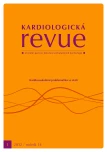-
Medical journals
- Career
New approaches to anticoagulant treatment for senior citizens with atrial fibrillation
Authors: J. Špác; Bohuslav Kianička
Authors‘ workplace: II. interní klinika LF MU, FN u sv. Anny v Brně
Published in: Kardiol Rev Int Med 2012, 14(1): 22-26
Overview
New approaches to anticoagulant treatment for senior citizens with atrial fibrillation. Anticoagulant treatment for senior citizens with atrial fibrillation represents one of the most frequently administered treatments, with a relatively safe risk profile. Before beginning the procedure, it is necessary to carry out a risk assessment to assist the selection of a suitable therapy and in assessment of the risk of side-effects (bleeding). Until recently, the only anticoagulant was warfarin, which has a number of shortcomings. In recent years, a number of anticoagulant substances have appeared that block the functioning of thrombin or factor X, and which have shown in a number of clinical tests greater effectiveness in the prevention of thromboses connected to lower prevalence of bleeding. New anticoagulants have not only a number of advantages, but also some limitations that must be respected during treatment so that the benefits of new substances are not negated through incorrect use in practice.
Keywords:
anticoagulation treatment – atrial fibrillation – warfarin – gatrans – xabans
Sources
1. Lip GY, Nieuwlaat R, Pisters R et al. Refining clinical risk stratification for predicting stroke and thromboembolism in atrial fibrillation using a novel risk factor-based approach: the Euro Heart Survey on Atrial Fibrillation. Chest 2010; 137 : 263–272.
2. van Walraven C, Hart RG, Connolly S et al. Effect of age on stroke prevention therapy in patients with atrial fibrillation: the atrial fibrillation investigators. Stroke 2009; 40 : 1410–1416.
3. Hylek EM, Evans-Molina C, Shea C et al. Major Hemorrhage and Tolerability of Warfarin in the First Year of Therapy Among Elderly Patients With Atrial Fibrillation. Circulation 2007; 115 : 2689–2696.
4. Gladstone DJ, Bui E, Fang J et al. Potentially Preventable Strokes in High-Risk Patients With Atrial Fibrillation Who Are Not Adequately Anticoagulated. Stroke 2009; 40 : 235–240.
5. Monte S, Macchia A, Pellegrini F et al. Antithrombotic treatment is strongly underused despite reducing overall mortality among high-risk elderly patients hospitalized with atrial fibrillation. Eur Heart J 2006; 27 : 2217–2223.
6. Siguret V, Gouin I, Debray M et al. Initiation of warfarin therapy in elderly medical inpatients: a safe and accurate regimen. Am J Med 2005; 118 : 137–142.
7. Gattellari M, Worthington J, Zwar N. Warfarin: an inconvenient truth [editorial]. Stroke 2009; 40 : 5–7.
8. van Walraven C, Oake N, Wells PS et al. Burden of potentially avoidable anticoagulant-associated hemorrhagic and thromboembolic events in the elderly. Chest 2007; 131 : 1508–1515.
9. Wysowski DK, Nourjah P, Swartz L. Bleeding complications with warfarin use: a prevalent adverse eff ect resulting in regulatory action. Arch Intern Med 2007; 167 : 1414–1419.
10. Lip GY, Frison L, Halperin JL et al. Comparative validation of a novel risk score for predicting bleeding risk in anticoagulated patients with atrial fibrillation: the HAS-BLED (Hypertension, Abnormal Renal/Liver Function, Stroke, Bleeding History or Predisposition, Labile INR, Elderly, Drugs/Alcohol Concomitantly) score. J Am Coll Cardiol 2011; 57 : 173–180.
11. Shah SV, Cage BF. Cost-effectiveness of dabigatran for stroke prophylaxis in atrial fibrillation. Circulation 2011; 123 : 2562–2570.
12. Granger CB, Alexander JH, McMurray JJ et al. ARISTOTLE Committees and Investigators. Apixaban versus warfarin in patients with atrial fibrillation. N Engl J Med 2011; 365 : 981–992.
13. Freeman JV, Zhu RP, Owens DK et al. Cost-effectiveness of dabigatran compared with warfarin for stroke prevention in atrial fibrillation. Ann Intern Med 2011; 154 : 1–11.
14. Hillarp A, Baghaei F,Fagerberg Blixter I et al. Effects of the oral, direct factor Xa inhibitor rivaroxaban on commonly used coagulation assays. J Thromb Haemost 2011; 9 : 133–139.
15. Cotton BA, McCarthy JJ, Holcomb JB. Acutely Injured Patients on Dabigatran. N Engl J Med 2011; 365 : 2039–2040.
Labels
Paediatric cardiology Internal medicine Cardiac surgery Cardiology
Article was published inCardiology Review

2012 Issue 1-
All articles in this issue
- Vitamin D and cardiovascular diseases
- Subclinical brain damage in older patients with hypertension and dementia
- Deep venous thrombosis and pulmonary embolism in geriatric medicine – two sides of the same coin
- New approaches to anticoagulant treatment for senior citizens with atrial fibrillation
- Complications of cardiac pacing in group of patients with higher age
- Complications of infrainguinal revascularization procedures in elderly patients
- Dyslipidemia in 2012
- Atherosclerosis of the intracranial arteries – current view, 2nd part
- An anusual diagnostics of implantable cardioverter-defibrillator lead perforation
- Cardiology Review
- Journal archive
- Current issue
- Online only
- About the journal
Most read in this issue- Complications of cardiac pacing in group of patients with higher age
- Vitamin D and cardiovascular diseases
- Deep venous thrombosis and pulmonary embolism in geriatric medicine – two sides of the same coin
- New approaches to anticoagulant treatment for senior citizens with atrial fibrillation
Login#ADS_BOTTOM_SCRIPTS#Forgotten passwordEnter the email address that you registered with. We will send you instructions on how to set a new password.
- Career

